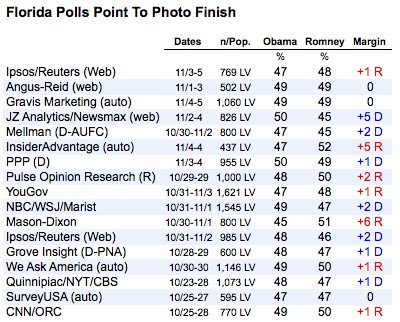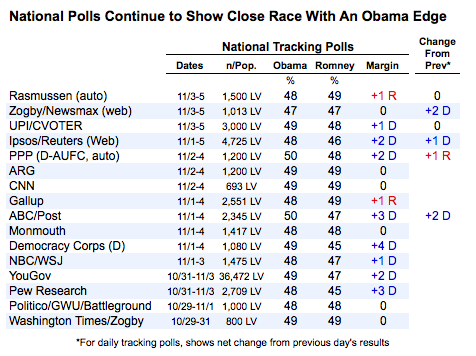On the eve of Election Day, I am a happy man. Why is this, you ask? Because the fundamentals-based forecasts issued by almost a dozen political scientists before Labor Day are – in the aggregate – looking remarkably prescient. The average prediction of those eleven models has Obama winning 50.3% of the two-party vote, while the median gives him 50.6%. So far, these forecasts seem to be holding up quite well, with both the RealClearPolitics and Pollster.com aggregate national poll showing this race, as measured by the popular vote, as essentially a dead heat, one day before the election. Score one for political science!
Of course, that doesn’t tell us who is going to win, which is what most of you want to know. Fear not! We need only consult the state-based forecasts issued by Drew Linzer, Sam Wang, Simon Jackman, and Tom Holbrook and Jay DeSart. (There are others out there, but these are the ones whose methods are most transparent, and with which I am most familiar. If you want a bit of background on their methods, see this article on “the rise of the quants” ). Although these forecast models differ in some of the particulars (whether to compensate for a pollster’s “house effect”, how to weight the state polls, the relative weight place on polls of likely vs. registered voters, etc.), they all operate on the same assumption: that state-based polls, taken in the aggregate, provide a very accurate indicator of who is going to win that state, particularly this late in the game. That, in turn, makes it relatively easy to put together an Electoral College forecast. All of them have done so, and as I’ve discussed in an earlier post, they all see it as more likely that Obama wins the Electoral College vote. This doesn’t mean they believe Romney can’t win – they just see it as less probable than an Obama victory.
The process by which these political scientists (Wang is actually a neuroscientist, but he gets honorary membership) put together their predictions is in stark contrast to the methods used by the traditional pundits. Consider this projection by Jay Cost, a very smart analyst who writes for the Weekly Standard. Cost believes Romney will win this election, and in explaining why, he took a shot at political science forecast models: “Both political science and the political polls too often imply a scientific precision that I no longer think actually exists in American politics. I have slowly learned that politics is a lot more art than science than I once believed. Accordingly, what follows is a prediction based on my interpretation of the lay of the land. I know others see it differently–and they could very well be right, and I could be wrong. I think Mitt Romney is likely to win next Tuesday.” As evidence for his prediction, Cost cites two points: Romney is leading among independents, and most voters think he will do a better job handling the economy.
Cost is not alone in thinking that Romney is going to win – there are some very smart people who have vast experience in electoral politics who agree with him. Here is a list of the most prominent political pundits, and their predictions. However, as I scan the list, I can’t help but notice that the bulk of people who agree with Cost in predicting a Romney victory are conservatives, including Karl Rove, Glenn Beck, Ari Fleischer, Jay Cost, Peggy Noonan and Dick Morris. On the other hand, many of the best-known liberal pundits – Markos Moulitsas, Jamelle Bouie, Jennifer Granholm, Donna Brazile and Cokie Roberts – think Obama will win. Now, all of them claim to be looking at the same data – the same polls, the same candidate strategies, the same advertisements, etc. How, then, can we explain why they end up with dramatically different predictions? More generally, why do liberals think Obama will win, and conservatives think Romney will?
The answer, I think, is that people – liberals, conservatives and everyone else – are very good at seeing patterns in data that suggest outcomes that conform to their preferences. Mind you – these aren’t implausible patterns – indeed, what makes them so seductive is that they are very plausible. Cost, for instance, is correct that most polls indicate that Romney is viewed as better able to handle the economy. But notice what he writes: “Poll after poll, I generally see the same thing. Romney has an edge on the economy. That includes most of the state polls.” At the same time, however, he evidently is discounting those same state polls that, looked at in the aggregate by political scientists, indicate that Obama is more likely to win the Electoral College. So, the question becomes: why value what the state polls say in one area – Romney’s handling of the economy – while discounting their overall projections that say Romney is more likely to lose?
The worry I have when analysts “interpret” data is that it leaves room for personal preferences to sneak in. Taken to an extreme, it leads to far-fetched inferences like this one tweeted earlier today by Peggy Noonan: “I suspect both Romney and Obama have a sense of what’s coming, and it’s part of why Romney looks so peaceful and Obama so roiled.” Really? She can see the election outcome by “reading” their faces? This presumes that both Obama and Romney know “what is coming” – highly unlikely in a 50/50 race- and that she has some method – a sixth sense? – for inferring when facial expressions reveal a person’s inner thoughts. Maybe she can see dead people too.
Ok. That was a cheap shot. Let me be clear. I think Noonan is a very smart person. Her memoir of her years as a Reagan speechwriter is one of the best accounts of life in the White House that I’ve ever read. But I don’t believe she can read faces.
And that leads me to my broader point. When I consider this latest election cycle, the most important development in how it has been covered, in my view, is the growing prominence of analysts whose methods are both more rigorous and more data-driven than what we are used to seeing from traditional “pundits”. I think we are witnessing a sea change in political analysis, one that will leave an indelible mark on future coverage of presidential elections. Increasingly, the traditional seat-of-the-pants, intuition-based method of analyzing elections is giving way to a less impressionistic mode of analysis. To be sure, these new methods are not infallible by any means. But they are a step forward. And political scientists are leading that movement.
To be fair to Cost, and Noonan, and all the rest of the “traditional” pundits, and the new ones too – they at least had the courage to put their professional reputations on the line and make a prediction. So I am going to do the same – tomorrow morning. I can tell you now – my prediction will be entirely atheoretical, and will be based on the latest state-based polling averages. But to make it interesting, I will make a wager: if my prediction regarding the winner tomorrow is incorrect, I will pay the bar bill (alcohol only) for everyone who attends the Election Night at the Grille, which Bert Johnson and I will be hosting. So keep your receipts! The festivities start at 7 p.m. and, as always, I’ll be living blogging the election returns while keeping the crowd at the Karl Rove Crossroads cafe – er, the Grille – entertained as well. For those in the area, I hope to see you tomorrow night. For the rest of you, please join me at this site. We are hoping to break our all time record for participation.
I’ll see you tomorrow.




